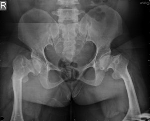
PSEUDOACHONDROPLASIA - REHABILITATION CHALLENGES AND PREVENTION OF MISDIAGNOSIS
Abstract
Patients with skeletal dysplasias face unique challenges because of their physical stature, psychosocial issues and medical complications. Rehabilitation can help them by improving their physical and social independence. Moreover, pseudoachondroplasia has often been mistaken for classical achondroplasia which is the most common type of short limbed dwarfism. Accuracy of diagnosis is important for genetic counseling and patient management. . In this report, we present the case of a 37 year old lady who was earlier diagnosed to have achondroplasia. She presented to us with multiple somatic complaints and difficulty in her activities of daily living. While admitted under us, based on the clinical and radiological findings, a diagnosis of pseudoachondroplasia was made. This report describes the features that differentiate the two entities and discusses the rehabilitation challenges and management of these patients. Keyword :Achondroplasia, Pseudoachondroplasia, Rehabilitation, Skeletal dysplasia ehabilitation of persons with skeletal dysplasias helps them by improving social and physical independence. Misbeliefs that such people have limited abilities need to be erased in order to help them maximize their independence. Apart from this, there have been instances where few cases have been misdiagnosed as Achondroplasia instead of Pseudochondroplasia. We present the case of a 37 year old lady who had been diagnosed to have achondroplasia earlier and presented to us with multiple somatic complaints. On detailed evaluation, she was diagnosed to have Pseudoachondroplasia. This report highlights the differences between the two entities and to the best of our knowledge is the first report which addresses the rehabilitation challenges of these patients.
Full Text:
PDFReferences
Pseudoachondroplasia: A rare cause of rhizomelic dwarfism. Anupam Tandon et al. Oct-Dec 2008, Indian J Orthop, pp. 477–479.
Diverse mutations in the gene for cartilage oligomeric matrix protein in the pseudoachondroplasiamultiple epiphyseal dysplasia disease spectrum. Briggs MD et al. 1998, Am J Hum Genet.
Mutations in exon 17B of cartilage oligomeric matrix protein (COMP) cause pseudoachondroplasia. Hecht JT et al. 1995, Nat Genet.
Mutations in the transmembrane domain of FGFR3 cause the most common genetic form of dwarfism, achondroplasia. Shiang R et al. 2, July 29, 1995, Cell, Vol. 78, pp. 335-42. 5. Herring, John A. Tachdijan’s Paediatric Orthopedics. 4th. 2007. Chapter 30.
Pseudoachondroplasla,a report of 13 cases. Heselson, N. G. and Beighton, P. 50, 1977, British Journal of Radiology, pp. 473-482.
Pseudoachondroplasia: clinical diagnosis at different ages and comparison of autosomal dominant and recessive types. A review
Refbacks
- There are currently no refbacks.

This work is licensed under a Creative Commons Attribution-NoDerivatives 4.0 International License.
An initiative of The Tamil Nadu Dr M.G.R. Medical University